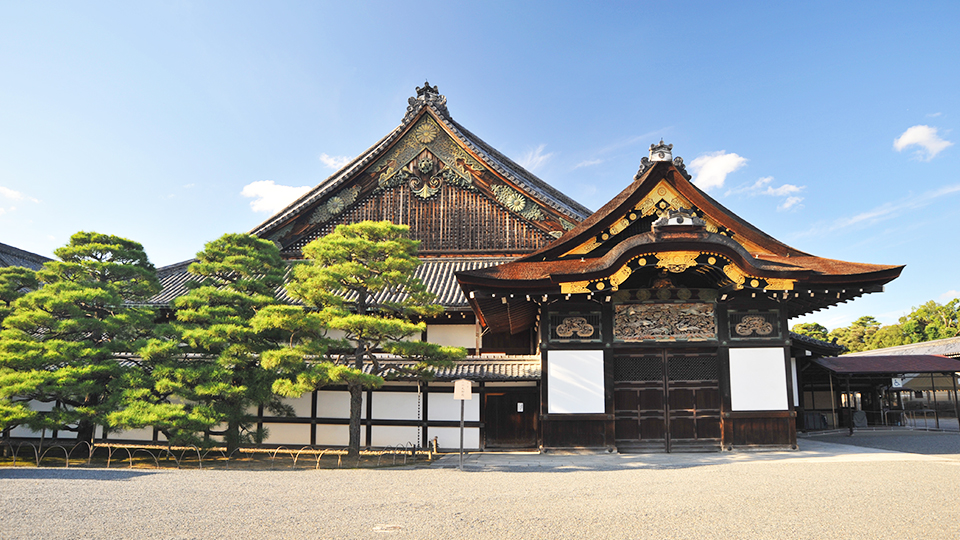
The Palace consists of six connected buildings, and is archetypical of the shoin-zukuri architectural style, which was perfected at the beginning of the Edo period (1603–1867). The Palace is designated as a National Treasure since it is the only surviving example of a fortified palace complex. The interiors of the Palace are magnificently decorated with wall paintings by the Kano School, intricately carved transoms between the rooms, and exquisite metalwork fittings, befitting the Kyoto residence of the Shogun.
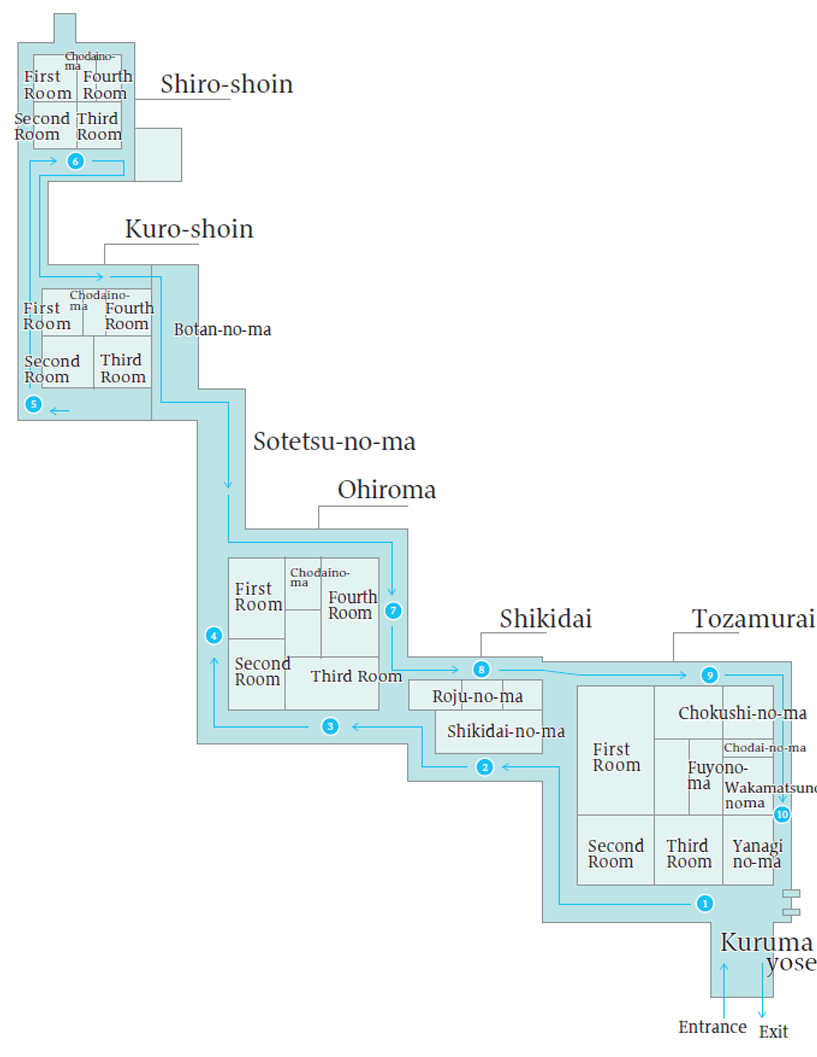
-
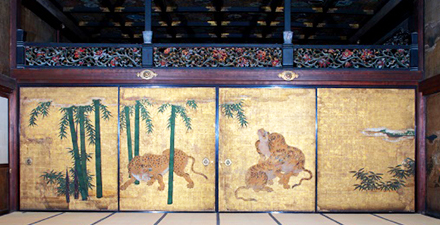
Chikurin-gunko-zu (Painting of bamboo and tigers), Tozamurai, Third Room-
Tozamurai Ichi-no-ma, Ni-no-ma, San-no-ma (First, Second and Third Rooms)
The first and largest section of the Palace, the Tozamurai served as waiting rooms for feudal lords when they visited the Palace. The first thing that the visitor to the Palace saw, the grandeur of these rooms, with their paintings on gold of ferocious tigers, was designed to express the authority of the Tokugawa Shogun. These rooms were also known as the Tora-no-ma, or Tiger rooms, for their wall paintings.
-
-
Shikidai (Reception Room)
The Shikidai reception room connects the reception areas of the Palace with the formal audience chambers, and it was here that visitors to the Castle would present gifts for the Shogun. Any business or messages for the Shogun were also first communicated here. This building is divided into a front section known as the Shikidai-no-ma (reception room) and a rear section called the Roju-no-ma (senior councilors’ room). Feudal lords would meet with the senior councilors here. The pine trees are an auspicious metaphor for everlasting prosperity.
-
-
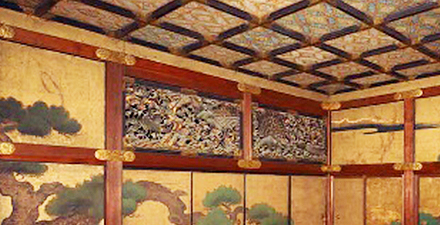
Ohiroma, Third Room (transom)-
Ohiroma San-no-ma (Third Room)
The openwork carvings between the rooms in this and the other rooms of the Ohiroma are particularly noteworthy, being carved differently on either side of a single piece of cypress wood over 35 cm thick. Also worth noting are the decorative metalwork fittings adorning the horizontal beams (nageshi) of the room. They are made of decorated and gilt copper, in the form of bouquets of flowers wrapped in paper as a gift.
-
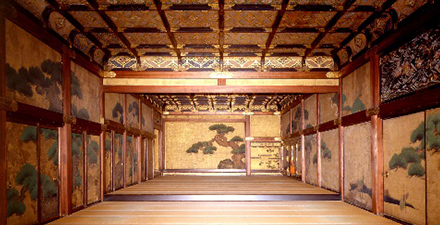
Ohiroma Ichi-no-ma, Ni-no-ma (First and Second Rooms)-
Ohiroma Ichi-no-ma, Ni-no-ma (First and Second Rooms)
The Ohiroma, or Grand Hall, is the main section of the Palace, and contains the official audience rooms where the Shogun met with feudal lords and the Imperial Court nobility. The two main rooms are the First Room, which is the upper level room, and the Second Room, on the lower level. During audiences, the Shogun is believed to have sat in the First Room, facing south, as rulers in Japan traditionally did. The First Room is fitted with an alcove (toko-no-ma), where a triptych of hanging scrolls would have hung, and staggered shelves (chigaidana, to the right of the toko-no-ma), where works of art would have been displayed. There is an ornamental doorway, called a chodai-gamae, on the right side of the room (with the red tassels), and a writing desk alcove on the left side. These are characteristic components of the shoin-zukuri style. Wall paintings are by Kano Tan’yu.
-
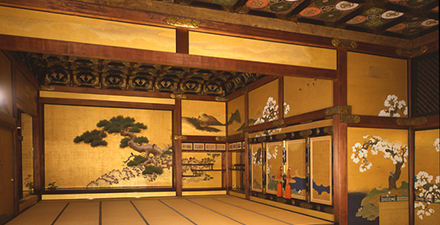
Kuro-shoin, view of First Room from Second Room Kuro-shoin, Botan-no-ma-
Kuro-shoin
This room was also known as the Kohiroma, or Smaller Grand Hall, during the Edo period, since it was used for official functions and was second only in importance to the Ohiroma. The Shogun met with high-ranking court nobles and with feudal lords with close ties to the Tokugawa family here, hence the more intimate nature of the architecture. The first and second rooms of the Kuro-shoin were also known as the Sakura-no-ma, or cherry blossom rooms, after the beautiful murals of cherry trees in full bloom. The changing of the seasons is incorporated into the paintings of this room. There is a light sprinkling of snow on the pine trees depicted behind the Shogun’s seat, and the other paintings include plum and cherry blossoms. Plums flower in late winter, before the cherry blossoms in the early spring. The paintings are by Kano Tan’yu’s brother, Naonobu.
-
-
Shiro-shoin
These rooms in the Shiro-shoin were also known as the Goza-no-ma (literally sitting room) in the Edo period and it is believed that these three rooms were the Shogun’s private quarters. Surrounded by ink wash paintings, the decorative scheme is very different from other parts of the Palace, creating an atmosphere of quiet calm. Themes of Chinese origin have been depicted, with a panoramic mural of the West Lake (a famous landscape in Zhejiang, China) in the First and Second Rooms, and famous figures from Chinese history and legend in the Third Room.
-
-
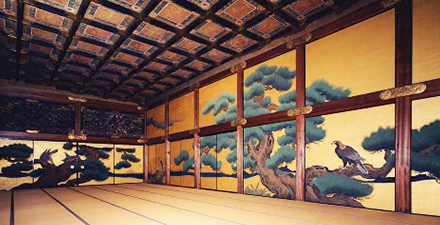
-
Ohiroma Yon-no-ma (Fourth Room)
It is said that weapons were displayed here when the Shogun was in residence. The Matsutaka-zu wall painting of a hawk perched on a massive pine tree is the most famous wall painting in the Palace, and incorporates features typical of the Momoyama period of the late 16th century.
-
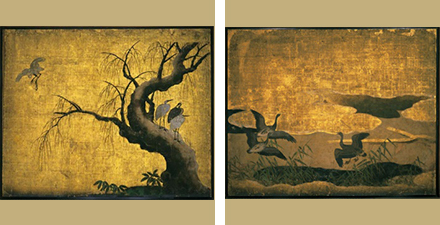
-
Shikidai: Roju-no-ma (Senior Councilor’s Room)
This room served as the waiting room for senior councilors. The paintings in the First and Second Rooms depict geese in the spring, summer, and autumn, with egrets and willow trees in a winter scene in the Third Room. Unlike the other rooms in the Palace, the wall section above the horizontal beams is white, creating a much more understated decorative scheme.
-
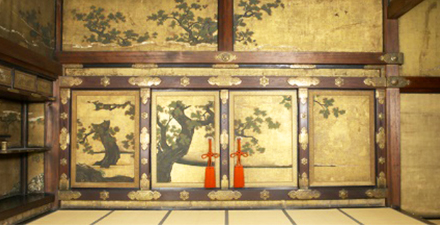
-
Tozamurai: Chokushi-no-ma(Imperial Messenger’s Room)
A very important room in the Palace, this was used when the Shogun met with messengers from the Imperial Court. The wall paintings here depict a refreshing early-summer scene of green maple leaves against a background of water.
-
-
Tozamurai: Yanagi-no-ma (Willow Room)
Willow trees are depicted in this room, lending a sophisticated, aristocratic air to the space, which echoes the oral themes in the adjoining Chokushi-no-ma, Fuyo-no-ma (Cotton Rosemallow room) and Wakamatu-no-ma (Young Pine Room).
-
-
Tozamurai Ichi-no-ma, Ni-no-ma, San-no-ma (First, Second and Third Rooms)

Chikurin-gunko-zu (Painting of bamboo and tigers), Tozamurai, Third Room- The first and largest section of the Palace, the Tozamurai served as waiting rooms for feudal lords when they visited the Palace. The first thing that the visitor to the Palace saw, the grandeur of these rooms, with their paintings on gold of ferocious tigers, was designed to express the authority of the Tokugawa Shogun. These rooms were also known as the Tora-no-ma, or Tiger rooms, for their wall paintings.
-
Shikidai (Reception Room)
- The Shikidai reception room connects the reception areas of the Palace with the formal audience chambers, and it was here that visitors to the Castle would present gifts for the Shogun. Any business or messages for the Shogun were also first communicated here. This building is divided into a front section known as the Shikidai-no-ma (reception room) and a rear section called the Roju-no-ma (senior councilors’ room). Feudal lords would meet with the senior councilors here. The pine trees are an auspicious metaphor for everlasting prosperity.
-
Ohiroma San-no-ma (Third Room)

Ohiroma, Third Room (transom)- The openwork carvings between the rooms in this and the other rooms of the Ohiroma are particularly noteworthy, being carved differently on either side of a single piece of cypress wood over 35 cm thick. Also worth noting are the decorative metalwork fittings adorning the horizontal beams (nageshi) of the room. They are made of decorated and gilt copper, in the form of bouquets of flowers wrapped in paper as a gift.
-
Ohiroma Ichi-no-ma, Ni-no-ma (First and Second Rooms)

Ohiroma Ichi-no-ma, Ni-no-ma (First and Second Rooms)- The Ohiroma, or Grand Hall, is the main section of the Palace, and contains the official audience rooms where the Shogun met with feudal lords and the Imperial Court nobility. The two main rooms are the First Room, which is the upper level room, and the Second Room, on the lower level. During audiences, the Shogun is believed to have sat in the First Room, facing south, as rulers in Japan traditionally did. The First Room is fitted with an alcove (toko-no-ma), where a triptych of hanging scrolls would have hung, and staggered shelves (chigaidana, to the right of the toko-no-ma), where works of art would have been displayed. There is an ornamental doorway, called a chodai-gamae, on the right side of the room (with the red tassels), and a writing desk alcove on the left side. These are characteristic components of the shoin-zukuri style. Wall paintings are by Kano Tan’yu.
-
Kuro-shoin

Kuro-shoin, view of First Room from Second Room Kuro-shoin, Botan-no-ma- This room was also known as the Kohiroma, or Smaller Grand Hall, during the Edo period, since it was used for official functions and was second only in importance to the Ohiroma. The Shogun met with high-ranking court nobles and with feudal lords with close ties to the Tokugawa family here, hence the more intimate nature of the architecture. The first and second rooms of the Kuro-shoin were also known as the Sakura-no-ma, or cherry blossom rooms, after the beautiful murals of cherry trees in full bloom. The changing of the seasons is incorporated into the paintings of this room. There is a light sprinkling of snow on the pine trees depicted behind the Shogun’s seat, and the other paintings include plum and cherry blossoms. Plums flower in late winter, before the cherry blossoms in the early spring. The paintings are by Kano Tan’yu’s brother, Naonobu.
-
Shiro-shoin
- These rooms in the Shiro-shoin were also known as the Goza-no-ma (literally sitting room) in the Edo period and it is believed that these three rooms were the Shogun’s private quarters. Surrounded by ink wash paintings, the decorative scheme is very different from other parts of the Palace, creating an atmosphere of quiet calm. Themes of Chinese origin have been depicted, with a panoramic mural of the West Lake (a famous landscape in Zhejiang, China) in the First and Second Rooms, and famous figures from Chinese history and legend in the Third Room.
-
Ohiroma Yon-no-ma (Fourth Room)
-
Shikidai: Roju-no-ma (Senior Councilor’s Room)

- This room served as the waiting room for senior councilors. The paintings in the First and Second Rooms depict geese in the spring, summer, and autumn, with egrets and willow trees in a winter scene in the Third Room. Unlike the other rooms in the Palace, the wall section above the horizontal beams is white, creating a much more understated decorative scheme.
-
Tozamurai: Chokushi-no-ma(Imperial Messenger’s Room)
-
Tozamurai: Yanagi-no-ma (Willow Room)
- Willow trees are depicted in this room, lending a sophisticated, aristocratic air to the space, which echoes the oral themes in the adjoining Chokushi-no-ma, Fuyo-no-ma (Cotton Rosemallow room) and Wakamatu-no-ma (Young Pine Room).
Ninomaru-goten Palace Nightingale Corridor
The floorboards of the Palace sound like the song of a nightingale when people walk down the corridor. This is caused by clamps moving against nails driven into the wooden beams supporting the floor. It is said, mistakenly, that this was intended to announce the presence of intruders.
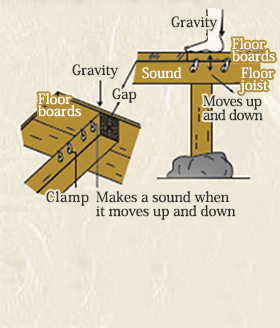
Ninomaru-goten Palace Wall paintings
There are over 3,600 wall paintings inside the Palace, including many from the Kan’ei era (1624–1644). 1,016 of these paintings are designated as Important Cultural Properties. The Kan’ei era murals are by the young master painter Kano Tan’yu of the Kano School of painting, which enjoyed the patronage of the Tokugawa shoguns. They were painted when the castle was remodeled for the Imperial visit by Emperor Go-Mizuno-o in 1626.

- 大広間四の間障壁画《松鷹図》
Garden [Special Place of Scenic Beauty]
This pond garden faces the western side of the Ohiroma of the Palace. It is believed to have been renovated in preparation for the imperial visit by Emperor Go-Mizunoo in 1626. The sakuji-bugyos (officials in charge of architecture and construction matters), including Kobori Enshu, were engaged in the work of the renovation. The islands in the middle of the pond are said to be the horai-jima. The garden was initially surrounded by corridors connecting the Kuro-shoin, the Ohiroma, and Gyoko–goten Palace, which does not exist today but means it was designed to be viewed from many directions.



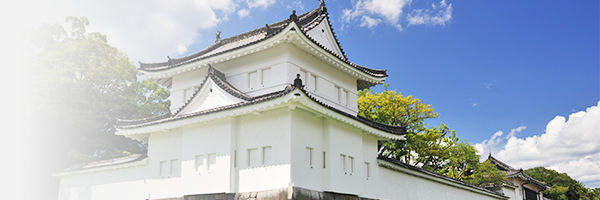
![Garden [Special Place of Scenic Beauty]](/wp-content/themes/nijojo/assets/img/introduction/highlights/teien/img_teien_ninomaru_01.png)
![Garden [Special Place of Scenic Beauty]](/wp-content/themes/nijojo/assets/img/introduction/highlights/teien/img_teien_ninomaru_02.png)
![Garden [Special Place of Scenic Beauty]](/wp-content/themes/nijojo/assets/img/introduction/highlights/teien/img_teien_ninomaru_03.png)